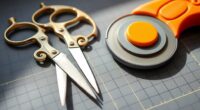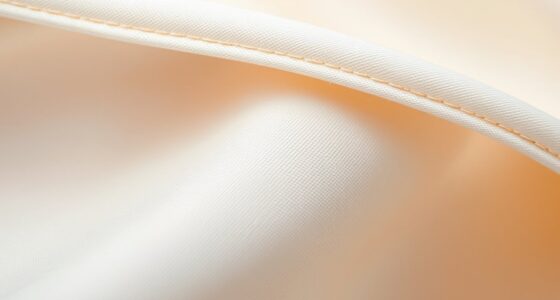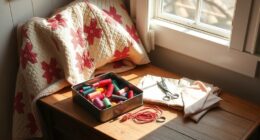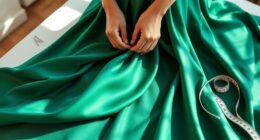To trim cushions like high-end decor, start by choosing sturdy, complementary fabrics for piping that match your style. Cut fabric strips with seam allowances and fold them snugly over piping cords, sewing carefully for a crisp finish. Pin and sew the piping along cushion edges, keeping it aligned and even. Mastering these techniques elevates your project with a polished look. Keep going, and you’ll discover how to perfect your piping and create stunning, professional results.
Key Takeaways
- Choose durable, high-quality fabrics that complement your decor and are easy to sew for a professional look.
- Cut fabric strips with seam allowances, then fold over piping cord for a snug, even fit.
- Pin piping along cushion edges carefully to ensure alignment before sewing for a clean finish.
- Sew piping with steady, precise stitches, maintaining consistent tension and positioning throughout the process.
- Practice and attention to detail in fabric selection and installation elevate your cushions to high-end decor standards.

Are you interested in tackling your plumbing projects on your own? If so, you’ll want to start with the basics, and that includes understanding how to choose the right fabric and handle piping installation. While it might seem unrelated at first, both elements are essential for creating a polished, professional look—whether you’re working on piping for a decorative project or actual plumbing. The key is to pay attention to fabric selection to ensure durability and aesthetics, and to understand the piping installation process for a clean, secure finish.
Master fabric choices and piping techniques for professional DIY results in decor or plumbing projects
When it comes to fabric selection, you want to choose materials that suit your project’s purpose. For piping trims or cushion covers, opt for fabrics that are sturdy yet flexible enough to hold their shape. Heavy-duty cotton, linen, or even upholstery-grade fabrics work well because they resist wear and tear, maintaining their appearance over time. If you’re making piping for decorative cushions, select fabrics that complement your overall decor theme, but don’t compromise on quality. The fabric’s texture and color should match your vision, whether you’re aiming for a sleek modern look or a cozy, traditional vibe. Once you’ve picked the fabric, you’ll find it easier to cut and sew the piping in a way that looks finished and high-end.
Now, piping installation involves a few precise steps to ensure your project looks professional. First, cut your fabric strips with enough length to wrap comfortably around your piping cord, leaving some extra for seam allowances. Fold the fabric over the piping cord and sew it carefully, making sure it’s snug but not too tight. Then, position the piping along the edge of your cushion or fabric piece, pinning it in place before sewing it down. This process requires steady hands and attention to detail, but with patience, you’ll achieve a clean, tailored finish. The key is to keep the piping aligned and even as you sew, so the final look is crisp and polished. Additionally, understanding the integration of AI in design tools can help streamline your workflow and ensure precision in your piping craftsmanship.
Incorporating good fabric selection and proper piping installation techniques transforms a simple cushion into a high-end decor piece. It’s all about choosing the right materials and taking your time during the sewing process. Once you master these fundamentals, you’ll find it much easier to create professional-looking piping trims that elevate your DIY projects. Whether you’re refurbishing furniture or adding a decorative touch to your home, understanding these basics makes the work more enjoyable and your results more impressive. With practice, you’ll gain confidence, and soon, piping will become a rewarding part of your DIY toolkit.
Frequently Asked Questions
Can I Use Any Fabric for Piping Cushions?
You can use a variety of fabric types for piping cushions, but it’s best to choose fabrics that are sturdy and maintain their shape, like cotton, linen, or leather. Consider piping color options that complement your cushion fabric to create a polished look. Avoid overly stretchy or delicate fabrics that might not hold the piping well. With the right fabric and color choices, your cushions will look professional and stylish.
What Tools Are Essential for Piping DIY Projects?
For your piping DIY projects, you’ll need essential tools like a sewing machine with adjustable settings to handle thicker fabrics and piping cord material. Make sure your machine’s settings are optimized for precision, and use sharp pins or clips to keep the piping aligned. A piping foot attachment makes sewing easier, ensuring a clean finish. Having these tools ready helps you achieve professional-looking results effortlessly.
How Do I Choose the Right Piping Cord Thickness?
When choosing the right piping cord thickness, consider your project’s look and fabric compatibility. Thinner cords, like 1/8 inch, give a subtle finish, while thicker cords, like ¼ inch, create a bold, defined edge. Review different piping cord types to find one that suits your fabric’s weight and texture. Test a small piece first to see how it enhances your cushions’ appearance, ensuring a professional, high-end look.
Can I Add Piping to Curved Cushion Edges?
Adding piping to curved cushion edges might seem intimidating, but it’s totally doable! You can absolutely sew piping on curved edges—just take your time and maintain piping tension as you sew. Use a curved or piping foot for better control, and gently ease the piping around the curves. With patience, your cushions will look professionally finished, transforming your space into a luxurious haven faster than you can say “high-end decor!”
How Do I Hide Seams for a Professional Finish?
To hide seams for a professional finish, focus on seam concealment and finishing techniques. You can press seams open or to one side, then topstitch close to the edge for a clean look. Consider using a seam binding or a narrow strip of fabric to cover raw edges. These finishing techniques guarantee your seams blend seamlessly, giving your cushions a polished, high-end appearance.
Conclusion
Now that you’ve mastered DIY piping, your cushions will look like they’ve stepped straight out of a high-end decor magazine. With a little patience and a steady hand, you’ve turned a simple project into a work of art—like weaving magic into everyday items. Keep experimenting and refining your technique, and soon your home will be adorned with custom touches that speak of your creativity. After all, beautiful decor is just a piping away!









